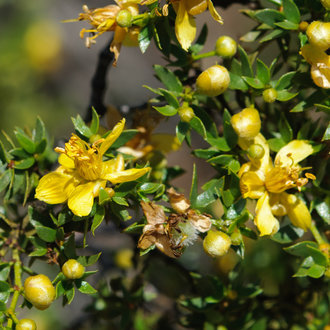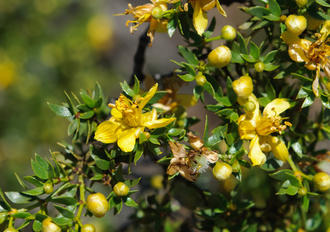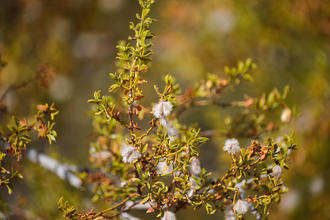Creosote Bush (Larrea tridentata (DC.) Coville)
Also known as creosotebush, creasotebush (misspelling).
↑Summary
A native bush of the deserts of southwestern North America, and one of the most important woody plants in this region.
↑Range - Expand
| Legend | Color |
| Native | |
| Native or Not Present |
This tentative map is based on our own research. It may have limited data on Canada and/or Mexico, and there is some subjectivity in our assignment of plants as introduced vs. expanded. Read more in this blog post.
Although this plant occurs somewhere in each of these regions, it may only occur in a small part of some or all of them.
↑Habitat
A dominant or co-dominant plant in most of the Mojave, Sonoran, and Chihuahuan deserts. Most frequent in harsh, arid sites, where it makes up most of the woody vegetation. Also occurs in transitions between desert and grasslands and xeric riparian areas, and in open communities of viscid acacia, mesquite, or Joshua tree and big galleta.
↑Uses
Used in landscaping throughout its range, where it is valued for being one of the few woody plants that can thrive in desert conditions.
Used traditionally by Native Americans for a variety of medicinal purposes. Also used indirectly, as host for the insect Tachardiella larreae, which produces a wax-like substance that can be softened by heating, and used to seal jars.
↑Links & External Resources
• Creosote Bush | Fire Effects Information System (FEIS) (About This Site)
• Larrea tridentata (creosote bush) | USDA PLANTS Database (About This Site)
• Creosote Bush | Virginia Tech Dendrology Factsheets (About This Site)
• Larrea tridentata | Biota of North America Project (BONAP) (About This Site)
• Larrea tridentata | NatureServe Explorer (About This Site)
• Larrea tridentata | Flora of North America (About This Site)





